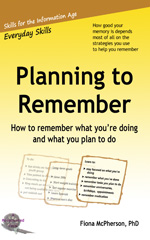There is a very common form of forgetfulness that is not really a failure of memory. When we get in our car to drive to place A and find ourselves instead on the road to the more familiar place B, this is not a failure of memory. When we clear the table and find ourselves putting the margarine in the dishwasher or the dirty plate in the fridge, this is not a failure of memory. When we go into a room intending to do one thing and do something else instead, this is not, really, a failure of memory.
These are absentminded errors, and they happen to all of us. They have also been termed action slips, and this term is useful because it points more precisely to the nature of these errors. Let's look at the characteristics of action slips:
- they usually occur during the performance of tasks that are so highly practiced they are largely automatic
- they usually occur when we are preoccupied or distracted
- many involve intrusions of other habitual actions that share some characteristics with the intended action
- such habit intrusions are more likely to occur when:
- we're departing in some way from our usual routine (for example, you decide to stop adding milk and sugar to your coffee, then finding yourself doing it automatically)
- the situation has changed, demanding a change in our usual routine (for example, a much-visited shop moves premises, but you keep going to its old location)
- the situation shares features with a highly familiar situation (for example, you try and open a friend's car with your own car key)
Other types of action slips are:
- place-losing errors: where you've lost your "place" in an action sequence, and so omit or repeat part of the sequence (for example, because of wheat sensitivities in my family, I make our own bread; accordingly, it is a highly practiced recipe, and I add all the ingredients in a fixed order. If something happens to distract me in the course of it, I may be unsure where I am in the sequence, and risk omitting or repeating an ingredient)
- blends: where you get confused between two active tasks (for example, you write an email while thinking about the next email you're going to write, and address the current email to the correspondent for the second email)
- reversals: where you get confused between parts of the same task (for example, you put an empty ice cube tray in the freezer, then turn to the tap to fill it)
You can see from all this that these everyday errors occur in the context of action sequences - that is, sequences of actions that we have practiced so often they have become automatic. Dressing, undressing, washing, making coffee or tea, even making quite complicated recipes - these are all common examples of action sequences.
You can see why action slip is therefore a good name for these types of error.
Is there anything we can do to minimize action slips? Well, the standard advice is to pay attention to what you're doing, but of course the whole point of action sequences is that they free our mind from needing to pay attention, so this is not a strategy I particularly recommend. However, if there are some action slips that you are particularly prone to, you might want to try this.
The most useful thing you can do is simply be aware of the circumstances that set you up for such errors. Then you can either:
- make a sterling effort to pay attention when it's important to you (for example, both my partner and I are careful when we are driving and need to depart from familiar routes, to remind ourselves - or each other - of our destination at key points), or
- use an object to signal that you have done something, or remind you where you are in a sequence (to take the recipe example again, you could move used ingredients to a particular part of the kitchen bench), or
- decide it's not important!
- Harris, J.E. & Morris, P.E. (eds.) 1984. Everyday memory, actions and absent-mindedness. Academic Press.
- Reason, J.T. & Mysielska, K. 1982. Absent-minded? The psychology of mental lapses and everyday errors. Englewood Cliffs, NJ.: Prentice-Hall.
